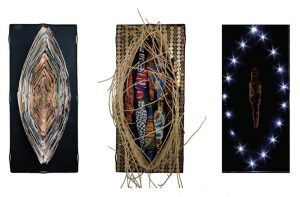ANY exhibition whose title features the word “Masters” is certain to evoke a range of responses from the creative community regarding the selection process. Who gets included and why? How does one qualify as a Master artist? Why this person and not the other?
While these may or may not have been questions asked of the recently-concluded CARIFESTA XIII Master’s Exhibition: History and Infinity, the show’s curator, Therese Hadchity explained that the selection of six regional artists was not, in any way, an attempt to establish an exclusive professional hierarchy.

Instead, the works of these artists were used to tease out much larger themes that would have been sources of engagement for many artists throughout the region over the last few decades.
As such the exhibition was conceptualised to examine “different nodes on the hypothetical plane that unfolds between perceptions of ‘history’ and ‘infinity’ […] as the ultimate determinant for Caribbean existence,”as Hadchity explains.
“Like so many artists of their generation(s), the six participants in this exhibition can be regarded as dedicated respondents to the Caribbean’s history and particular concerns. While their starting points may be the individual experience, a general premise for these practices has thus been their focus on matters of collective importance.
“While this feature makes the artists especially compatible with the spirit of CARIFESTA, it also makes them stakeholders in an ongoing exchange about origins, history, cultural self-assertion, regional integration and global dynamics, and, trailing right behind those pre-occupations, about the assumptions, biases and silences that have suffused Caribbean historiography and affected the region’s pursuit of a distinctive identity,” she said.

According to Hadchity, the individual creative approaches linked to ideas of ‘History’ and ‘Infinity’ and the subsequent positioning of resulting works often within contemporary (and complimentary) art practices, all point to a serious contemplation of our own potential within a global context. They
encourage the examination of our history and the many ways it has influenced our individual and collective personalities, while also calling into question how any attempt to change this ‘course’ could possibly be realised.
“Wherever the exhibition’s artists stand on this matter, their position tends to be supported or complicated by a (strong or weak) perception of ‘infinity’, which in this exhibition have ranged from Whittle’s vision of an eternal life cycle as history’s ‘parallel track’, to Breleur’s poetic ‘re-incarnation’ of the deceased (or diseased), and his suggestion of ever multiplying identities and possibilities. They have also included Ras Ishi’s suggestion of infinite r

epetition as history’s ‘anti-thesis’ and Gardner’s and Greaves’ projection of an infinite void, which can interrupt the flow of history. In Gardner’s case, history itself thus appears to be ‘irrational’, while Greaves projects a conflict between history and the irrational. Morrison, in turn, implicitly interrogates the relationship between history and the promise of ‘infinite possibilities’ enabled by new technologies.

What has emerged is thus a spectrum of positions and negotiations between history and infinity – between the perception of a forward-moving chain of actions and various apprehensions of the unpredictable, incomprehensible, chaotic or multidimensional, which altogether posit a host of further questions about human agency, and how we can interpret and position ourselves in the world.”
The CARIFESTA XIII Masters Exhibition: History and Infinity featured works from Joscelyn Gardner (Barbados), Nick Whittle (Barbados), Ernest Breleur (Martinique), Ras Ishi Butcher (Barbados), Stanley Greaves (Guyana) and Petrona Morrison (Jamaica). The exhibition opened on August 20th at three locations including the Grande Salle, the Nidhe Israel Synagogue Gallery and Queens Park Gallery and closed on August 27th.

Therese Hadchity (Ph.D.) was the founder of the Zemicon Gallery in Bridgetown (2000-2010). She is a free-lance critic, curator and teacher. Her doctoral dissertation was on the emergence of a post-nationalist hegemony in visual arts criticism and practices in the Anglophone Caribbean.




.png)









